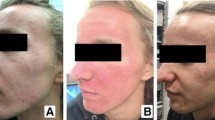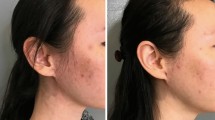Abstract
Acne vulgaris is one of the most common dermatologic disorders encountered in everyday practice. Treatment options for this often psychologically scarring disease are numerous and, for many individuals, provide relief from the disorder. However, factors such as antibiotic resistance and slow onset of action from many topical therapies have led researchers to seek out alternative therapies, especially for those suffering from moderate to severe inflammatory acne vulgaris. Lasers and light sources are finding increased usage in the treatment of inflammatory acne vulgaris. Light sources including blue lights and intense pulsed lights are becoming regular additions to routine medical management to enhance the therapeutic response. Finally, photodynamic therapy may change many of the acne vulgaris paradigms, as its place is being defined in the treatment of moderate to severe inflammatory acne vulgaris. More and more clinical trials are showing the effectiveness of 5-aminolevulinic acid and photodynamic therapy in the treatment of moderate to severe inflammatory acne vulgaris.


Similar content being viewed by others
Notes
A thorough review of PDT.
A review of PDT and thought on its future.
The first ALA-PDT paper on acne.
The first ALA-PDT blue light study.
References
Leyden JJ (1997) Therapy for acne vulgaris. N Engl J Med 336:1156–1162
Coates P, Vyakrnam S, Eady EA et al (2002) Prevalence of antibiotic-resistant propionibacteria on the skin of acne patients: 10-year surveillance data and snapshot distribution study. Br J Dermatol 146:840–848
Velicer CM et al (2004) Antibiotic use in relation to the risk of breast cancer. JAMA 291:827–835
Margolis DV, Bowe WP, Hoffstad O et al (2005) Antibiotic treatment of acne may be associated with upper respiratory tract infections. Arch Dermatol 141:1132–1136
Ellis CN, Krach KJ (2001) Uses and complications of isotretinoin therapy. J Am Acad Dermatol 45:S150–S157
Sigurdsson V et al (1997) Phototherapy of acne vulgaris with visible light. Dermatology 194:256–260
Taub AF (2004) Photodynamic therapy in dermatology: history and horizons. J Drugs Dermatol 3:S8–S25
Gold MH, Goldman MP (2004) 5-aminolevulinic acid photodynamic therapy: where we have been and where we are going. Dermatol Surg 30:1077–1083, discussion 1083–1084
Touma DJ, Gilchrest BA (2003) Topical photodynamic therapy: a new tool in cosmetic dermatology. Semin Cutan Med Surg 22:124–130
Kawada A et al (2002) Acne phototherapy with a high-intensity, enhanced narrow-band, blue light source: an open study and in vitro investigation. J Dermatol Sci 30:129–135
Shalita AR, Harth Y, Elman M (2003) Acne photoclearing using a novel, high intensity, enhanced, narrow-band, blue light source. Clin Appl Notes 9(1)
Gold MH (2003) The utilization of ALA-PDT and a new photoclearing device for the treatment of severe inflammatory acne vulgaris—results of an initial clinical trial. J Lasers Surg Med 215(S):46
Papageorgiou P et al (2000) Phototherapy with blue (415 nm) and red (660 nm) light in the treatment of acne vulgaris. Br J Dermatol 142:973–978
Meffert H, Gaunitz K, Gutewort T et al (1990) Therapy of acne with visible light: decreased irradiation time by using a blue-light high energy lamp. Dermatol Monsschr 176:560–597
Goldman MP, Boyce S (2003) A single-center study of aminolevulinic acid and 417 nm photodynamic therapy in the treatment of moderate to severe acne vulgaris. J Drugs Dermatol 2:393–396
Gold MH, Goldman MP (2004) A multi-center investigatory study of the treatment of mild to moderate inflammatory acne vulgaris of the face with visible blue light in comparison to topical 1% clindamycin antibiotic solution. J Am Acad Dermatol 50(s):56
Dierickx CC (2004) Lasers, light and radiofrequency for treatment of acne. Med Laser Appl 19:196–204
Bowes LE, Manstein D, Anderson RR (2003) Effect of 532 nm KTP laser exposure on acne and sebaceous glands. Lasers Med Sci 18:S6–S7
Seaton ED, Charakida A, Mouser PE et al (2003) Pulsed-dye laser treatment for inflammatory acne vulgaris: randomized controlled trial. Lancet 362:1347–1352
Orringer JS, Kang S, Hamilton T, Schumacher W et al (2004) Treatment of acne vulgaris with a pulsed dye laser: a randomized controlled trial. JAMA 291:2834–2839
Paithankar DY, Ross EV, Saleh BA, Blair MA, Graham BS (2002) Acne treatment with a 1,450 nm wavelength laser and cryogen spray cooling. Lasers Surg Med 31:106–114
Elman M, Lask G (2004) The role of pulsed light and heat energy (LHE™) in acne clearance. J Cosmet Laser Ther 6:91–95
Dierickx CC (2004) Treatment of acne vulgaris with a variable-filtration IPL system. Lasers Surg Med S16:66
Friedman PM, Jih MH, Kimyai-Asadi A et al (2004) Treatment of inflammatory facial acne vulgaris with the 1450 nm diode laser: a pilot study. Dermatol Surg 30:147–151
Tuchin VV, Genina EA, Bashkatov AN et al (2003) A pilot study of ICG laser therapy of acne vulgaris: photodynamic and photothermolysis treatment. Lasers Surg Med 33:296–310
Lloyd JR, Mirkov M (2002) Selective photothermolysis of the sebaceous glands for acne treatment. Lasers Surg Med 31:115–120
Ruiz-Esparza J, Gomez JB (2003) Nonablative radiofrequency for active acne vulgaris: the use of deep dermal heat in the treatment of moderate to severe active acne vulgaris (thermotherapy): a report of 22 patients. Dermatol Surg 29:333–339
Hongcharu W et al (2000) Topical ALA-photodynamic therapy for the treatment of acne vulgaris. J Invest Dermatol 115(2):183–192
Itoh Y et al (2000) Photodynamic therapy for acne vulgaris with topical 5-aminolevulinic acid. Arch Dermatol 136(9):1093–1095
Itoh Y et al (2001) Photodynamic therapy of acne vulgaris with topical delta aminolevulinic acid and incoherent light in Japanese patients. Br J Dermatol 144:575–579
Gold MH (2003) The utilization of ALA-PDT and a new photoclearing device for the treatment of severe inflammatory acne vulgaris—results of an initial clinical trial. J Lasers Surg Med 15(S):46
Gold MH (2004) A multi-center study of photodynamic therapy in the treatment of moderate to severe inflammatory acne vulgaris with topical 20% 5-aminolevulinic acid and a new intense pulsed light source. J Am Acad Dermatol 50(s):54
Taub AF (2004) PDT for the treatment of acne: a pilot study. J Drugs Dermatol 3:S10–S14
Santos AV, Belo VG, Santos G (2005) Effectiveness of photodynamic therapy with topical 5-aminolevulinic acid and intense pulsed light versus intense pulsed light alone in the treatment of acne vulgaris: comparative study. Dermatol Surg 31:910–915
Rojanamatin J, Choawawanich P (2006) Treatment of inflammatory facial acne vulgaris with intense pulsed light (IPL) and short contact of topical 5-aminolevulinic acid (ALA): a pilot study. Dermatol Surg 32:991–997
Wiegell SR, Wulf HC (2006) Photodynamic therapy of acne vulgaris using 5-aminolevulinic acid versus methyl aminolevulinate. J Am Acad Dermatol 54(4):647–651 (Apr)
Horio T et al (2003) Photodynamic therapy of sebaceous gland hyperplasia with topical 5-aminolevulinic acid and slide projector. Br J Dermatol 148:1274–1276
Alster TS, Tanzi EL (2003) Photodynamic therapy with topical aminolevulinic acid and pulsed dye laser irradiation for sebaceous hyperplasia. J Drugs Dermatol 2(S):501–504
Richey DF, Hopson B (2004) Treatment of sebaceous hyperplasia by photodynamic therapy. Cosmet Dermatol 17:525–529
Gold MH et al (2004) Treatment of sebaceous gland hyperplasia by photodynamic therapy with 5-aminolevulinic acid and a blue light source or intense pulsed light source. J Drugs Dermatol 3(6):S5–S8
Gold MH et al (2004) ALA-PDT and blue light therapy for hidradenitis suppurativa. J Drugs Dermatol 3(S):32–39
Strauss RM, Pollock B, Stables GI et al (2005) Photodynamic therapy using aminolevulinic acid does not lead to clinical improvement in hidradenitis suppurativa. Br J Dermatol 152(4):803–804 (Apr)
Author information
Authors and Affiliations
Corresponding author
Additional information
Dr. Gold is a consultant for DUSA Pharmaceuticals and Lumenis. Dr. Gold performs research, speaks for, and owns stock in both companies as well as other device companies including Sciton, Alma Lasers, Innotech, and Cynosure.
Rights and permissions
About this article
Cite this article
Gold, M.H. Acne and PDT: new techniques with lasers and light sources. Lasers Med Sci 22, 67–72 (2007). https://doi.org/10.1007/s10103-006-0420-z
Received:
Accepted:
Published:
Issue Date:
DOI: https://doi.org/10.1007/s10103-006-0420-z




